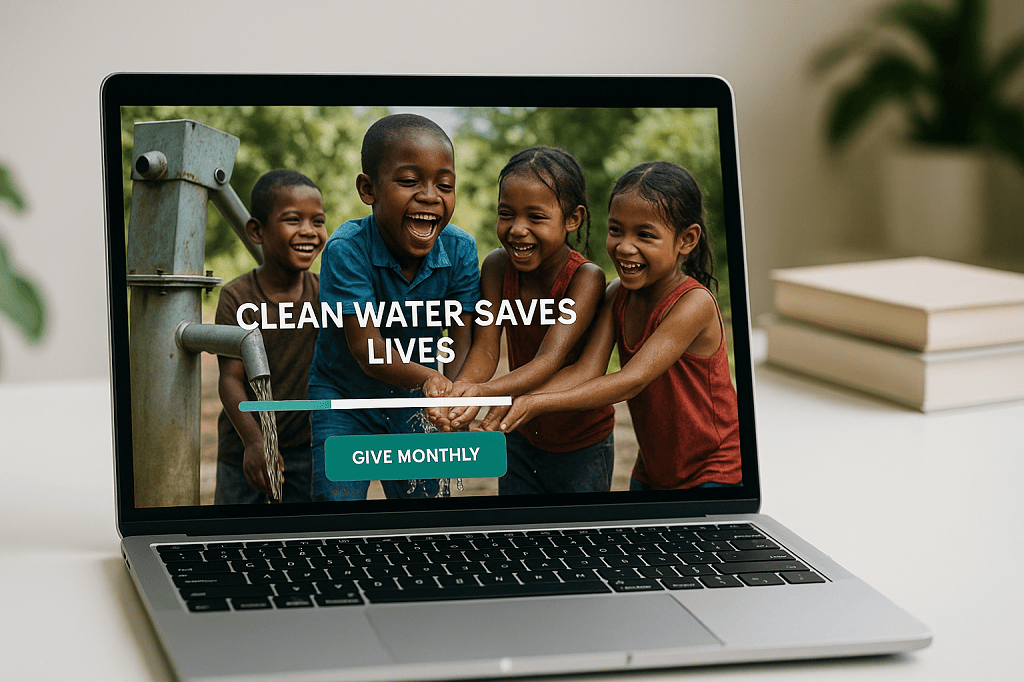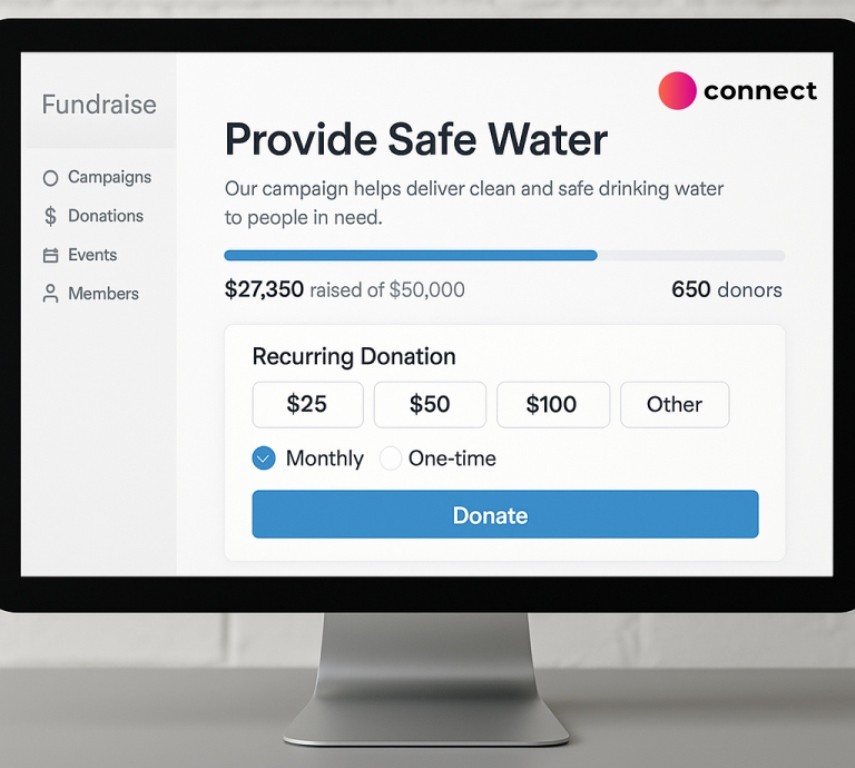How to Fundraise for a Nonprofit: Beginner’s Guide
Successful fundraising starts with strategy, not guesswork. This beginner’s guide covers how to fundraise for a nonprofit using clear goals, recurring support, digital tools, events, corporate partnerships, and real campaign examples. Learn how nonprofits plan, launch, and scale fundraising — and how Scrile Connect can help build a custom donation platform tailored to your mission.

how to fundraise for a nonprofit
Nonprofits do more than run programs. They train volunteers, report to grant makers, maintain software, pay staff, rent space, track impact, and keep the lights on. All of that takes money, and relying on occasional donations rarely provides the budget needed to plan ahead. Learning how to fundraise for a nonprofit now means understanding not only where money comes from, but how to build support that lasts longer than one campaign.
Funding models have shifted. People give through text links, QR codes, Instagram stories, live events, embedded donation buttons, monthly subscriptions, and peer-to-peer campaigns where supporters raise funds on a charity’s behalf. Donors want clarity: where money goes, how it’s used, and what changes because of it. They return more often when they feel informed and involved rather than just asked.
Organizations also have more tools than before—payment processors built for nonprofits, recurring automation, donor CRMs, match-giving programs, and custom fundraising platforms that centralize community, content, and transactions in one place.
This guide walks through practical approaches to raising funds, from planning a campaign to choosing the right channels and learning from successful nonprofits. We’ll also cover how technology fits into modern giving and why some organizations eventually build their own fundraising platforms instead of relying on generic tools.
Understanding the Money Behind Nonprofits
Money in a nonprofit doesn’t behave like money in a traditional business. Revenue often arrives from several unrelated sources, sometimes tied to specific projects, sometimes unrestricted, and often spaced months apart. Budgets stretch across outreach, staff salaries, legal compliance, marketing, grant reporting, security policies, and tech tools that keep operations running. A nonprofit might look like a mission-driven community from the outside, but behind the scenes it operates closer to a social enterprise with a funding model that never stops moving.
To make smart decisions about how to fundraise for a nonprofit, it helps to understand the different types of funding. Operating funds keep day-to-day responsibilities alive—rent, payroll, bookkeeping, insurance, digital infrastructure. Program-restricted funds support direct mission work: building wells, buying equipment, running shelters, offering classes, or producing educational content. Mixing the two can cause accounting issues or even risk losing eligibility for certain grants.
Many teams also rely on software to track spending and donor activity. This is where nonprofit fundraising turns into data work—tagging transactions, tracking donor retention, segmenting audiences, and organizing year-end reports. The stronger the financial clarity, the easier it becomes to request support with confidence.
Where the Money Usually Comes From
These sources often blend together rather than replace one another:
- Individual donors — from small recurring givers to major philanthropists who support long-term projects.
- Corporate partnerships and sponsorships — financial support in exchange for visibility or social impact alignment.
- Grants and foundations — structured funding tied to impact reports and compliance terms.
- Events, merch, and peer-to-peer drives — community-driven contributions that work well with storytelling.
- Recurring support programs — automated monthly giving that creates stability.
Key Steps Before You Ask for Money

A fundraising campaign doesn’t start when you post a donation link. It starts much earlier—when the organization understands why it needs funds, how much it needs, and how donors will stay informed once money arrives. Many nonprofits jump straight into social posts or crowdfunding pages because they feel urgency. That energy helps, but planning prevents donor confusion and protects the team from scrambling halfway through a campaign.
The first step is defining the mission in real numbers rather than broad hopes. Instead of saying you support families, specify how many families, which region, and what each contribution pays for. People respond better to concrete outcomes than abstract good intentions. Teams also need to confirm compliance requirements: handling donations legally, storing payment data securely, honoring privacy rules, and preparing receipts or tax-deductible confirmations depending on region and status.
Messaging sits at the center of all this work. A clear story helps new supporters understand the need quickly: who benefits, how support is delivered, and how impact will be tracked. This is where storytelling, branding, and donation infrastructure meet. To understand how to raise money for a nonprofit, think of messaging as an ongoing relationship rather than a one-time pitch.
Campaigns also run smoother when internal logistics are ready before launch: payment processors linked, donation pages tested, confirmation emails written, thank-you messages prepared, and staff briefed on their roles. When launch day comes, the team can focus on spreading the word instead of fixing broken links.
Foundations of a Solid Campaign
A campaign feels structured—and trustworthy—when a few key elements are mapped out:
- Audience profiles with real motivations
Instead of “anyone who cares,” identify groups: alumni, parents, past volunteers, local businesses, or people already following the cause online. Different audiences respond to different messages. - Impact metrics that feel tangible
Show what donations accomplish. “$25 covers training materials for one student,” or “$100 funds one rescue mission.” People want numbers, not vague promises. - A budget that explains where funds go
Break down percentages for operations, outreach, staff, supplies, or program costs. Transparency builds credibility. - Donation tiers and goal structure
Suggested amounts guide giving behavior. Clear milestones help supporters feel momentum as totals rise.
When planning is done, the campaign stops feeling like a plea and starts feeling like a movement the community understands and trusts.
Fundraising Channels That Work

Most nonprofits grow by testing different ways to gather support. No single method fits every cause. A small animal rescue might thrive on monthly donors, while a museum leans on sponsorships and grants. Here are the channels most organizations rely on—each with a reason to try them and a quick example to spark ideas:
Direct donations and donor pages
The simplest format: a branded donation page with card, PayPal, and bank transfer options. Add short stories, photos, and progress bars to help people connect emotionally. Think of it as your fundraising home base.
Crowdfunding and peer-to-peer
Platforms like GoFundMe or CauseVox tap into social sharing. Supporters raise money on your behalf, spreading awareness faster. One family shelter launched a “$10 from 10 friends” challenge and reached its goal in days.
Memberships and recurring giving
Predictable support keeps services running. Offering perks like newsletters, behind-the-scenes updates, or small thank-you gifts encourages donors to stay month after month.
Corporate matching and sponsorships
Local businesses love partnering with causes that show impact close to home. A bakery might sponsor meals for an after-school program or match customer donations during a seasonal drive.
Merch and fundraising events
Branded shirts, volunteer-designed art, virtual walkathons, trivia nights—events create excitement. They work best when celebrating milestones or rallying around a clear mission.
Email and SMS fundraising
Not flashy, but incredibly effective. Emails carry storytelling and gratitude. Text messages prompt quick responses. Many nonprofits see their highest conversion rates here because communication goes straight to supporters.
Grant programs
More paperwork, bigger rewards. Foundations and government agencies often look for clear action plans and data-backed results—perfect for organizations already tracking impact.
Organic social media pushes
Short videos, quick stories, donation stickers, livestream Q&As—it all helps people feel closer to the work being done.
Choosing the Right Channel for Your Team
The best approach depends on your capacity and audience. A small nonprofit with two staff members can’t run gala dinners and corporate sponsorships at the same time. Focus brings better results, especially during early stages of fundraising for nonprofits. A simple framework helps narrow choices:
- Time and skills available — Who will create content, handle events, or manage tech?
- How urgent the funding need is — Quick cash favors crowdfunding or social drives.
- Size and loyalty of your community — Email lists and memberships grow over time.
- Budget for tools and promotions — Paid ads or big events require upfront costs.
Start where momentum already exists. Add complexity only when your team has room to breathe and supporters ask for more ways to get involved.
Real Examples & What We Can Learn

You can read guides all day, but nothing teaches faster than watching how other nonprofits gather support and keep people involved. Here are a few real-world approaches that worked because they matched the community, not just because they had a donation button.
One small literacy nonprofit in Ohio raised money by turning local book clubs into micro-fundraisers. Each club “adopted” a classroom for a semester and shared monthly updates with members about how kids were progressing. The organization didn’t need major sponsors—just consistent storytelling and a way to show results.
A clean-water initiative in East Africa took another route. They launched a donation page combining short field videos with monthly giving tiers priced like everyday habits: “One coffee = one week of clean water.” Members received voice notes from field staff, photos of equipment repairs, and maps showing project sites. That personal connection kept churn low and brought in recurring support over one-time spikes.
A city animal rescue group relied on community events instead of online pushes. They hosted weekend adoption fairs at a park with QR codes linking to donations and volunteer sign-ups. Costs were low because vendors donated snacks and tents, and local radio promoted the event for free. Their success came from visibility and people meeting animals face-to-face.
Here’s a quick snapshot comparing common campaign formats:
| Campaign Type | Cost Level | Donor Retention | Best Use Case |
| Crowdfunding | Low | Medium | Urgent needs or one-off projects |
| Recurring Programs | Medium | High | Long-term missions + predictable budgets |
| Corporate Sponsorships | Medium | Medium | Events, seasonal drives, brand partnerships |
| Grant Funding | High admin | High if awarded | Infrastructure, expansion, multi-year growth |
Patterns Behind Successful Campaigns
Even though approaches differ, a few shared habits show up again and again:
- Updates that feel personal, not mass-produced press releases
- A simple payment path across devices
- Clear stories about who benefits, not just numbers
- Visual progress markers — timelines, maps, totals, milestones
Organizations that refine these habits usually find it easier to explain how to raise funds for charity without exhausting their teams.
Practical Workflow: Running a Campaign Start to Finish

Planning is great. But eventually you need a repeatable process. Think of this as a working rhythm rather than a rigid formula. People donate because the story feels alive, so shaping the campaign as a sequence of actions makes it easier to keep momentum.
Here’s one way teams move from planning to execution:
- Set a measurable goal
Not “raise money for a program,” but something a donor can picture: 200 backpacks, six months of shelter food, 15 laptops for a training lab. A clear target helps you explain what success looks like and decide how much effort the campaign truly needs. - Choose fundraising channels
Pick the method that fits your capacity—not just what’s trendy. Crowdfunding works for urgency; recurring membership pages support long-term missions; physical events build community credibility. Many nonprofits blend two or three approaches instead of betting everything on one channel. - Create the page and payment infrastructure
Whether you use existing tools or a custom setup, the donation flow should load fast, display progress visibly, and make sure every tap feels intuitive on mobile. - Launch your messaging plan
Short videos, email sequences, local press, SMS reminders—whatever fits the audience. The key is consistency. Donors don’t act the first time they see something; they decide once the message sticks. - Run the campaign in real time
Share milestones, respond to comments, post mini-updates, celebrate small wins publicly. Campaigns move faster when supporters feel involved instead of being asked once and forgotten. - Track engagement and retention
Look past total donations. Which pages convert best? Who returned to donate again? Which posts brought traffic? - Renew and show impact
Close the loop by telling supporters what their help achieved. Nothing builds loyalty faster.
Build Your Own Fundraising Platform with Scrile Connect

Some nonprofits outgrow donation widgets, spreadsheets, and scattered tools. They want one place where donors can give, track their impact, and stay engaged over time. That’s where custom development matters.
Scrile Connect helps nonprofits build their own branded fundraising platforms—from donation portals to full community systems. It’s not a SaaS subscription with rigid settings. It’s a development service that shapes the product around your workflows, visuals, and fundraising model.
You can launch a simple donation website or a more complete hub with pages for campaigns, volunteer groups, events, and private supporter spaces. Everything works as one ecosystem instead of a mix of third-party tools.
What organizations often ask to build:
- Custom donation pages with flexible tiers, one-time and recurring billing, and multilingual layouts
- Donor analytics showing retention, contributions by campaign, and lifetime value
- Community features like member roles, private chats, and discussion groups
- Event tools for streaming, ticketing, and live fundraising
- Payments with multicurrency support, secure processors, and compliance
Every nonprofit runs differently—some rely on peer-to-peer challenges, others focus on monthly support or corporate sponsorships. With a custom build, you choose how each part works: email logic, donor onboarding, dashboards, reminders, and how campaigns stack over time. Your team controls branding, data, and upgrades, instead of waiting for a SaaS platform to roll out new features.
By investing in your own platform, you’re building infrastructure that supports long-term growth, not just the next campaign. And when you understand how to fundraise for a nonprofit as an ongoing system, tailored tools give those efforts room to expand.
Conclusion
Successful fundraising isn’t just collecting donations—it’s building a system that earns trust, keeps supporters engaged, and sustains programs long enough to create real impact. Clear goals, thoughtful messaging, and consistent follow-ups turn occasional donors into long-term partners. When teams understand how to fundraise for a nonprofit as a structured process, each campaign becomes easier to run and measure.
For nonprofits that want more control over their digital presence, custom technology can help. Scrile Connect offers development support for organizations that need their own branded fundraising website, donation flows, member dashboards, and communities. If you’re planning to grow fundraising beyond basic tools, explore what Scrile Connect can build with you.
FAQ
What is the fastest way to raise money for a nonprofit?
Speed comes from reach and simplicity. Social media pushes urgent messaging fast, peer-to-peer campaigns extend your audience through supporters, and virtual events allow donations in real time. Sponsorships, merch drops, and email blasts can also bring quick boosts when goals are clear.
Do and don’ts of fundraising?
Do keep messaging transparent, show impact, and track every donor so you nurture relationships over time. Don’t make vague appeals, ignore thank-yous, or rely on one-off campaigns without planning future engagement.
What are the rules of fundraising?
Fundraising must follow compliance laws, stay honest about where money goes, and document spending for accountability. Misleading donors is illegal and breaks trust. These principles apply regardless of platform—especially when learning how to fundraise for a nonprofit and scaling campaigns over time.
